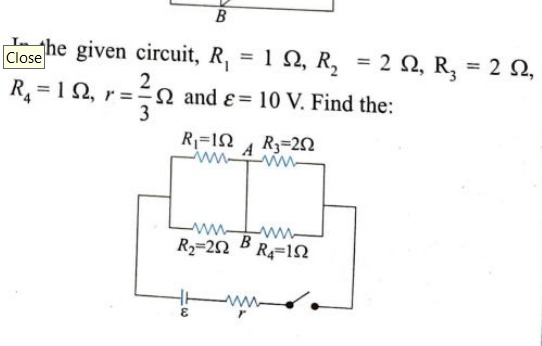Question
Question: In the given circuit, $R_1 = 1 \ \Omega$, $R_2 = 2 \ \Omega$, $R_3 = 2 \ \Omega$, $R_4 = 1 \ \Omega$...
In the given circuit, R1=1 Ω, R2=2 Ω, R3=2 Ω, R4=1 Ω, r=32 Ω and ε=10 V. Find the:

A
Total current from the battery and the potential difference between points A and B
B
Equivalent resistance of the circuit and the total current
C
Potential difference across R3 and R4
D
Current through R1 and R2
Answer
Total current from the battery: 1360 A, Potential difference between A and B (VAB): 1330 V
Explanation
Solution
- Calculate the equivalent resistance of the top branch (Rtop=R1+R3=1 Ω+2 Ω=3 Ω) and the bottom branch (Rbottom=R2+R4=2 Ω+1 Ω=3 Ω).
- Calculate the equivalent resistance of the parallel combination (Rparallel=Rtop+RbottomRtop×Rbottom=3+33×3=69=23 Ω).
- Calculate the total resistance of the circuit, including the internal resistance (Rtotal=Rparallel+r=23 Ω+32 Ω=69+64=613 Ω).
- Calculate the total current drawn from the battery using Ohm's Law (I=Rtotalε=613 Ω10 V=1360 A).
- Since the parallel branches have equal resistance, the total current splits equally (Itop=Ibottom=2I=1330 A).
- Calculate the potential at Node X (after internal resistance): VX=ε−I×r=10 V−1360 A×32 Ω=10−1340=1390 V.
- Calculate the potential at point A: VA=VX−Itop×R1=1390 V−1330 A×1 Ω=1360 V.
- Calculate the potential at point B: VB=VX−Ibottom×R2=1390 V−1330 A×2 Ω=1390−1360=1330 V.
- Calculate the potential difference between A and B: VAB=VA−VB=1360 V−1330 V=1330 V.
